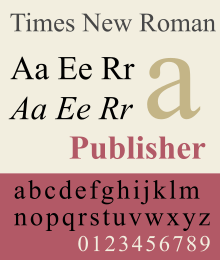Times (font)
|
|
|
| font | Times New Roman |
| category | Serif |
| Font family | Times |
| Font classification |
Baroque Antiqua PANOSE: 2263545234 |
| Font designer |
Stanley Morison Victor Lardent |
| Client | The Times of London |
| Type foundry | The Monotype Corporation |
| publication | 1931 |
| Based on | Plantin |
| Variations | Times New Roman Times New Roman PS MT Times New Roman MT Times Ten Times Europe |
| Alternative name | Times Roman |
| example | |

|
|
The Times is a Baroque Antiqua typeface originally designed by Stanley Morison and Victor Lardent in 1931 . There are now numerous variants of the original Times. The Times became popular as a computer font through products from Adobe , Microsoft and Apple , making it one of the best-known and most widely used fonts today.
There are several different representations about the exact history of the origins of the Times. There is agreement that the Times was designed under the direction of Morisons for the newspaper The Times and that he based the design of its lowercase letters on the designer Frank Hinman Pierponts .
To prepare the matrices which closed Times of London subcontracting agreements with both The Monotype Corporation and with Linotype & Machinery, Ltd. and also allowed them to publish the font themselves for free use after a year of exclusive use. Mergenthaler Linotype introduced the typeface 14 years later. Both Monotype and Linotype claim the trademark rights today.
The Times soon became widely used in the publishing industry and, although no longer used by The Times , continues to be a popular typeface in newspaper printing and office communications. It has several advantages to a newspaper typeface: It is robust, clear, and easy to read as well Economical in terms of space, therefore particularly suitable for narrow-column texts.
Since February 1, 2004, by order of the US State Department, all US diplomatic documents are to be printed in Times New Roman in 14 point instead of the previous Courier New in 12 point.
Times as a computer font
Its high level of awareness today in everyday life is based on the integration of Times variants in software products that have become widespread. A digital version of Times Roman was by Adobe in its first PostScript - interpreter (and thus laser printers integrated). Microsoft and Apple later shipped them out as part of their Windows and Mac OS operating systems .
Windows ships with Monotype's Times New Roman , while Mac OS includes Linotype's Times Roman . Nimbus Roman No9 L from URW Type Foundry is usually found on Unix-like systems . This is URW's public domain PostScript version of the Times Roman .
Times New Roman is Microsoft's name for the TrueType version of the Times New Roman PS , a narrower variant of Monotype's classic type. The PS version was introduced by Monotype at Microsoft's request in order to match the dimensions of the Times Roman (one of the PostScript core fonts Linotype). It has finer capital letters that were originally designed for printing German texts (since there are many more capital letters than English).
The differences between Times Roman and Times New Roman are largely in the trademark . However, there are stylistic differences that may not be noticeable letter by letter, but do so in direct comparison. The example below shows the three variants mentioned one below the other. There is also the Times Ten , a special version of the Times Roman for point sizes under 12, and the Times Europa , an even more robust version of the Times Roman for poor paper.
- Examples of Times
